Okinawa, Japan’s southernmost prefecture, is a popular vacation destination that is famous throughout the country for its picturesque beaches with crystalline waters, hosting one of the largest aquariums in the world, and unique food.
I’ve been fortunate enough to travel to Okinawa several times and Okinawan food, called Okinawa ryōri (沖縄料理, おきなわりょうり) is unlike any other I’ve come across in Japan. The colors, the textures, and the flavors almost make you feel like you’re having something other than Japanese food, which perhaps shouldn’t be much of a surprise when considering the history of Okinawa.
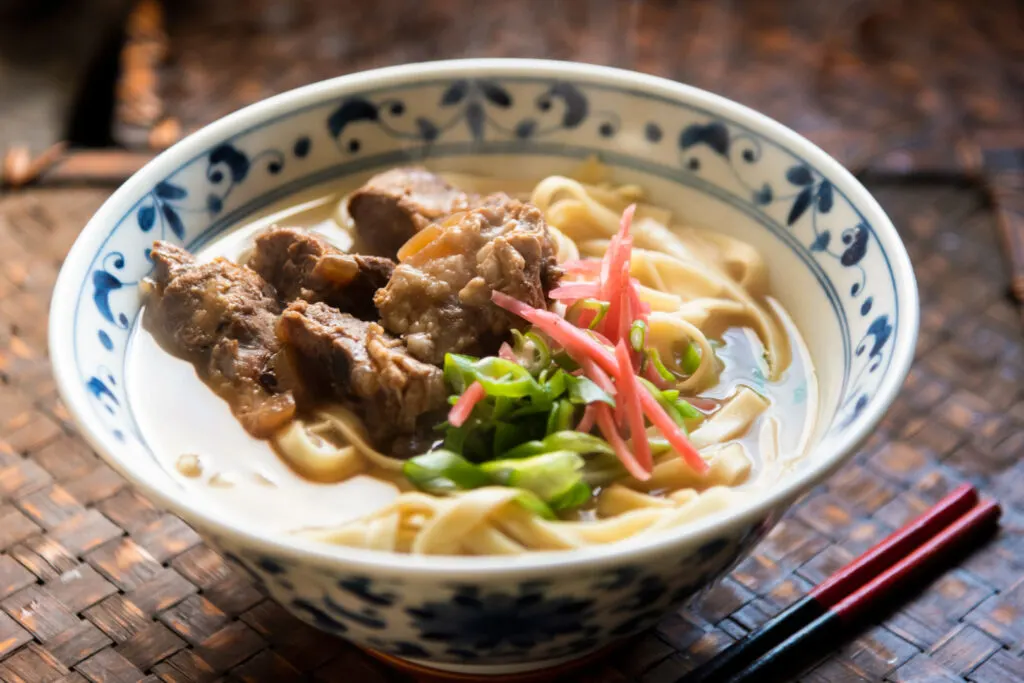
For a little over 400 years, Okinawa was an independent country called the Ryukyu (Ryūkyū) Kingdom. They engaged in trade across South Asian countries and served as a bridge between China and Japan before being annexed by Japan in 1879.
This is why when you visit Okinawa, you may notice that certain elements of their culture differ from that of mainland Japan. In fact, many Okinawan dishes that are still popular to this very day are known as Ryukyu Cuisine as they date back to the Ryukyu Kingdom era.
Although Okinawa might be too far for some to visit on a trip to Japan, the good news is that restaurants serving Okinawa ryōri can be found in major cities like Tokyo and Osaka. So if you haven’t had food from Okinawa before, get yourself acquainted through this article before you try.
Table of Contents
Goya Champuru

Goya Champuru (ゴーヤチャンプル, gōya champurū) is a quintessential Okinawan dish that originated during the Ryukyu Kingdom era. Ryukyu Cuisine is known for its nutritional benefits and as goya (bitter melon) is considered to be a superfood, Goya Champuru is no exception. It’s said to be especially good to eat in summer to help regain energy.
Although undoubtedly healthy, this stir-fry dish has a complex taste that people either love or hate. I’ll admit that at first, I wasn’t a fan as I found the goya to be too bitter; however, it quickly grew on me.
The goya’s bitterness is offset by the other ingredients, mainly salty scrambled eggs and meat, as well as its umami-filled seasonings like soy sauce. This helps keep the dish balanced and makes it taste surprisingly light for a stir-fry. The texture of crisp goya paired with fluffy and soft scrambled eggs also makes it enjoyable to eat.
As the word champurū means “mixture” in Okinawan, this dish can have a variety of additional ingredients that are mixed and stir-fried together, such as vegetables, tofu, pork, or spam.
There are also other types of champurū apart from Goya Champuru, such as Somin Champuru (ソーミンチャンプルー, sōmin champurū), which consists of stir-fried sōmen noodles (called sōmin in Okinawa), green onions, and meat, and Tofu Champuru (豆腐チャンプルー, tōfu champurū), which is a stir-fry featuring tofu, pork, and vegetables.
Okinawa Soba

With hundreds of restaurants dedicated to serving it, Okinawa Soba (沖縄そば, おきなわそば) is undoubtedly a popular dish in Okinawa.
Despite its name, however, Okinawa Soba’s noodles are not made out of buckwheat but wheat flour instead, making them more similar to udon. The noodles are flatter than udon, though, with some curl and a bit of a bite to them.
These noodles are served in a light tonkotsu (pork bone) and bonito broth, and topped with seasoned pork, pickled ginger, and green onions.
Yaeyama Soba
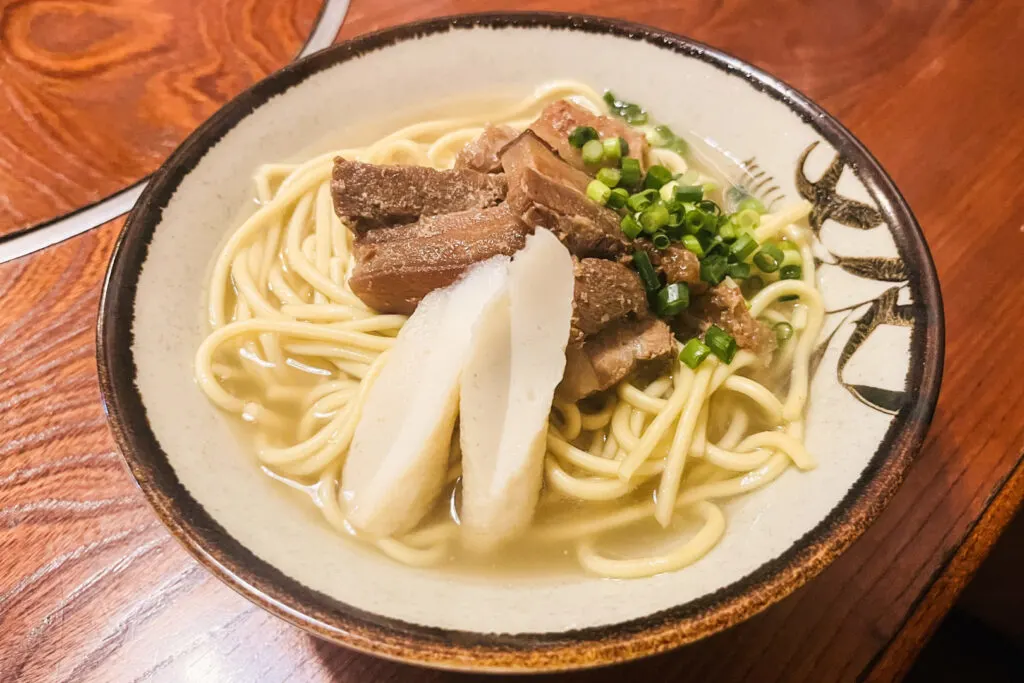
Yaeyama Soba (八重山そば, やえやまそば) is a type of Okinawa Soba that originates from the Yaeyama region, which is comprised of 23 remote islands in Okinawa, including Ishigaki and Iriomote.
Unlike Okinawa Soba, the noodles used in Yaeyama Soba are thin and relatively straight and the tonkotsu and bonito broth is a little lighter and sweeter.
Sea Grapes
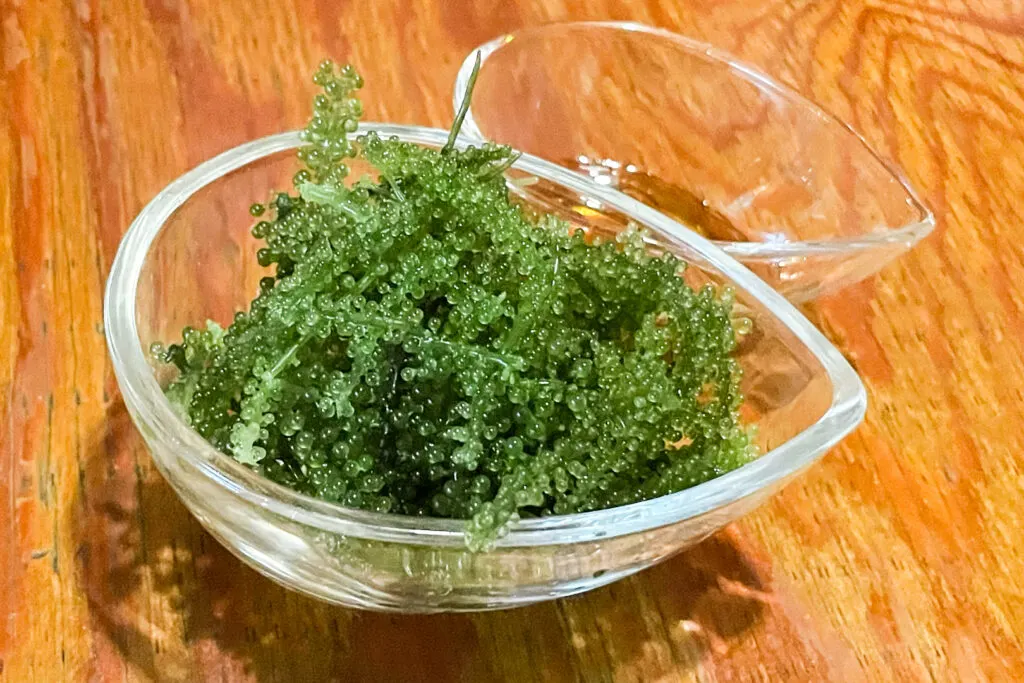
Sea Grapes or umi-budou (海ぶどう, umi-budō), are a type of seaweed comprised of tiny vibrant green bubbles and are also referred to as green caviar (グリーンキャビア). It’s more famous for its texture than taste, specifically the popping sensation of the bubbles, which is strangely addictive.
When chewed, the bubbles pop and release what I can only describe as a little bit of salty ocean water into your mouth. The taste is surprisingly light, though, which is why it is usually eaten with ponzu or soy sauce.
Umi-budou is also used as a topping for rice, udon, or sushi. Although it might seem intimidating to eat, I absolutely recommend giving it a try, perhaps one strand at first, because it is quite good.
Ninjin Shirishiri

Similar to kinpira gobō (shredded burdock root), this is a typical home-cooked side dish in Okinawa but instead of gobō, Ninjin Shirishiri (ニンジンシリシリ) uses shredded carrots (ninjin).
The shredded carrots are fried alongside canned tuna and eggs, making it a simple but nutritious and tasty dish.
Agu Pork

Pork is a meat that has been traditionally used in many Okinawan dishes, so perhaps it’s no surprise that there is a type of pork called Agu Pork (or アグー豚, Agū Buta) that has been bred on the island for hundreds of years after being brought to Okinawa from China.
Agu Pork is famous for its soft, melt-in-your-mouth texture, its sweetness, as well as its rich umami. It is commonly enjoyed in shabu-shabu and tonkatsu (fried pork cutlets), which is exactly how I have it when I am lucky enough to go to a restaurant that serves it. And let me tell you, Agu Pork is something you should not miss trying if you have the chance.
Best of all, Agu Pork has less cholesterol than standard pork, so you don’t have to feel guilty about pigging out a little.
Rafute

Rafute (ラフテー, rafutē) is another traditional Okinawan pork dish that comes from the Ryukyu Kingdom. It consists of pork belly that has been simmered in dashi, awamori (a type of distilled Okinawan liquor), soy sauce, and sugar, making it tender and flavorful.
Taco Rice
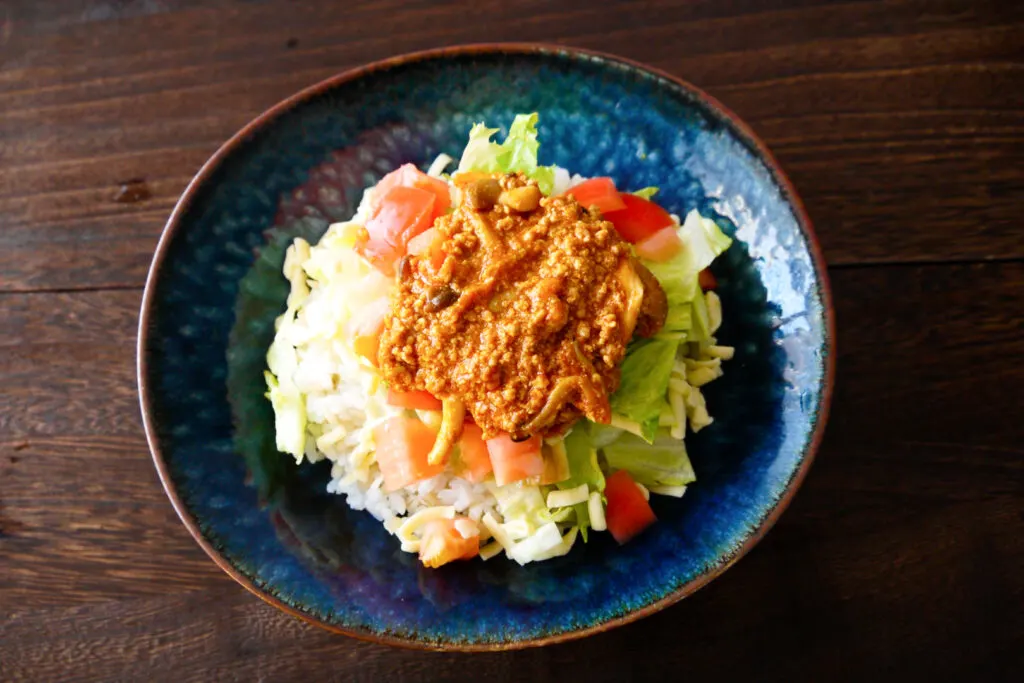
Taco Rice (タコライス) is something that surprised me when I first moved to Japan. Although it originated in Okinawa, this popular dish can be found at a number of restaurants and cafes throughout the country and is also easy to make at home.
Taco Rice is a blend of both East and West, consisting of rice topped with seasoned ground beef, shredded cheese, lettuce, tomatoes, and salsa. It might sound strange to those who have had taco ingredients in a shell and not on rice, but Taco Rice is definitely worth trying at least once.
Chinsuko
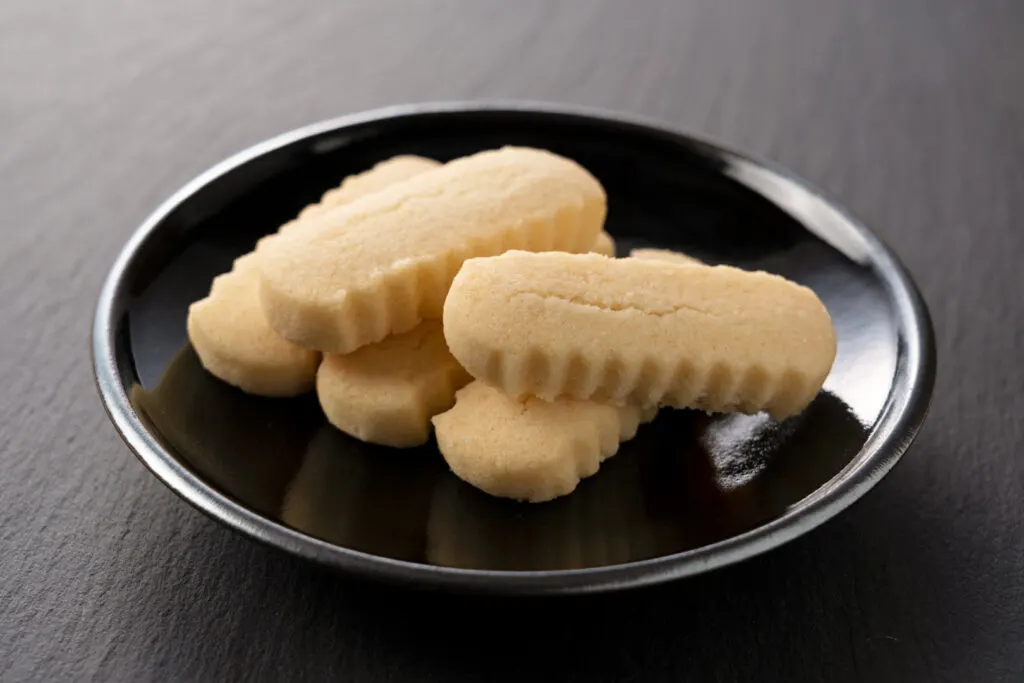
Chinsuko (ちんすこう, chinsukō) is a confectionary that has roots in the Ryukyu Kingdom and is said to be a fusion of Chinese and Japanese sweets. In the past, these small rectangular biscuits made of flour, lard, and sugar were reserved for only royalty and aristocracy on special occasions.
Nowadays, Chinsuko is one of the most popular souvenirs for tourists when visiting Okinawa. It’s easy to share as there are several individually wrapped packages in a box, they don’t expire quickly, and there are a variety of flavors such as beni-imo (Okinawan sweet potatoes), chocolate, brown sugar, and goya.
Sata Andagi
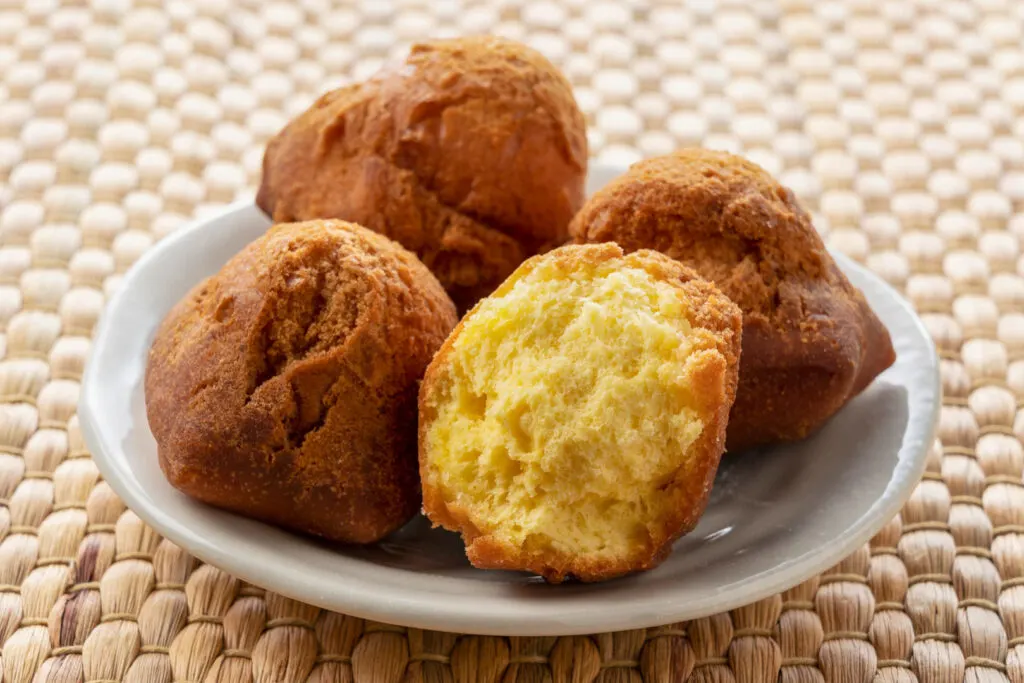
Like many Okinawan foods, Sata Andagi (サーターアンダギー, sātā andagii) has a long history and traditionally was a treat to enjoy during celebrations.
These round, fried sweets made of flour, eggs, and sugar resemble fritters or crispy donuts and are crunchy on the outside but soft inside. They taste best when fresh but are also common souvenirs and can be readily found at supermarkets and souvenir shops in Okinawa.
Blue Seal Ice Cream
Although fairly new in terms of food from Okinawa and perhaps not the most traditional, Blue Seal is a brand famous throughout the country and has origins in Okinawa, specifically the US military bases (the US has maintained a large military presence in Okinawa since WWII).
They offer a huge variety of ice cream flavors including ones unique to Okinawa, such as shiiquasa (a tangy Okinawan citrus fruit), beni-imo, and sugar cane.
Blue Seal has branches throughout the country, especially in major cities, so it’s worth checking if one is near you. Sometimes you can find their ice creams at convenience stores as well.
Awamori
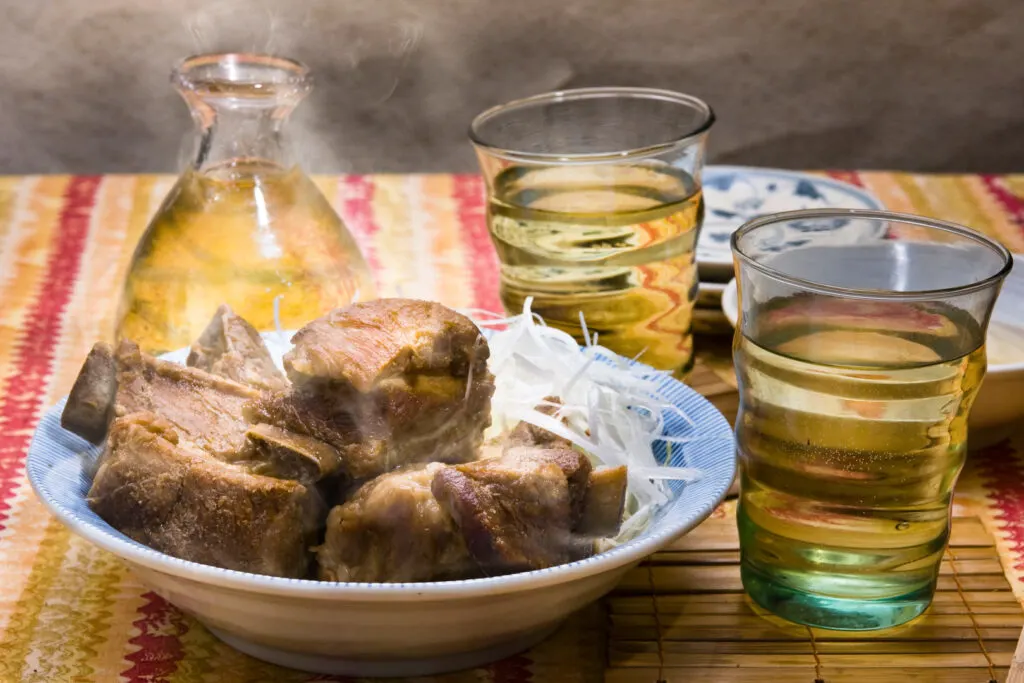
Awamori (泡盛, あわもり) is a spirit made of distilled Thai rice and black kōji mold. As its alcohol content ranges from around 30-40%, Awamori is quite strong and typically drank with water or on the rocks.
Awamori that is aged for more than three years is known as Kusu and tends to have a richer and more mellow taste similar to fine whisky or brandy.
If you visit Okinawa, you’re also likely to come across Habushu (ハブ酒), which is an alcoholic beverage with an Awamori base that is blended with honey and various herbs. This drink is named after the venomous Habu snake and true to its name, each bottle is aged with an entire snake inside! (Bottles are sold with or without the snake.)
Okinawa food at convenience stores

Lastly, if you make it down to Okinawa, make sure to stop by their convenience stores as well as they have food made of Okinawan ingredients that you won’t find anywhere else in Japan.
For instance, the last time I went to Okinawa, I stopped by LAWSON and enjoyed shiiquasa-flavored Karaage-Kun (LAWSON’s signature fried chicken) and Abura Miso with Agu Pork onigiri, which were both delicious. I almost want to hop back on a plane to Okinawa just to have that onigiri again!
Have you tasted Okinawan food? What dish would you most like to try?
Kay is a Canadian freelance translator and writer who has been in Japan for more than a decade. Having lived in the Chugoku, Kanto, and now the Kansai regions, she hopes to share their various local cuisine on JFG.
She also writes about her experiences being a mother in Japan on her website, Tiny Tot in Tokyo.
